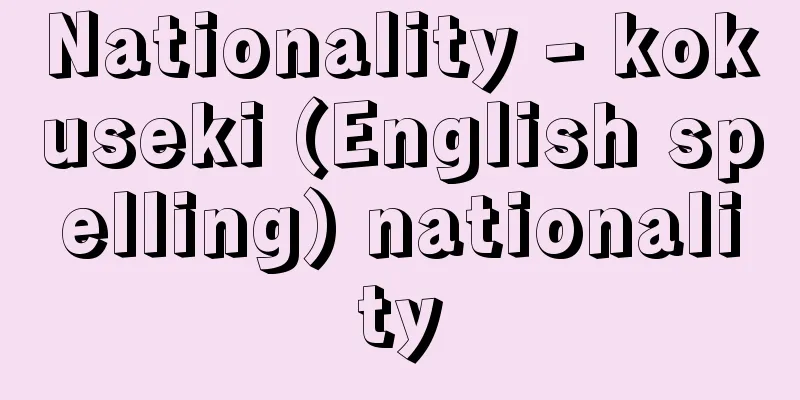Shimaji Mokurai - Shimaji Mokurai

|
A monk of the Jodo Shinshu Honganji school in the late Edo and Meiji periods. His childhood name was Kenchi. He was also known by the names Ekikei, Shukudo, Uden, Hokuho, and Rokurokudojin. He was born as the fourth son of Shimizu Enzui (a Honganji school scholar) at Sensho-ji Temple in Wada Village, Saba County, Suo Province (now Shunan City, Yamaguchi Prefecture), and later entered Myosei-ji Temple in Shimaji Village (now Tokuji Shimaji, Yamaguchi City), which is also a Honganji school, and took the surname Shimaji. He studied at Hagi Castle School from a young age, and studied Shinshu and Buddhist studies under Haraguchi Shinsui (1808-1893) at Kosho-ji Temple in Higo (Kumamoto Prefecture). In the spring of 1866 (Keio 2), he conspired with Ozu Tetsunen to set up a school in Hagi to educate apprentices from Shinshu temples in Nagato and Suo. In 1868 (Meiji 1), he went to Kyoto and proposed reforms to the Honpa Honganji Temple, and in 1871 opened the Nisshindo Temple in Kanda Imagawakoji, Tokyo, and published the newspaper Shinbun Zasshi. In January 1872, he accompanied Umegami Takuyu (1835-1907) to Europe, inspecting religious conditions overseas and returning to Japan in July. In 1873, he began a movement to separate the Shinto-Buddhist alliance from the Daikyoin, leading to the collapse of the Daikyoin. While serving as the executive director of the Honpa Honganji Temple, he also opened the Women's Literary School (the precursor to Chiyoda Women's School) in 1888. He also participated in the establishment of the Japanese Red Cross Society. His books include "A Brief History of Buddhism in the Three Countries" in three volumes and "Outline of Buddhist Sects." [Hidetoshi Ikeda July 19, 2017] "Shimaji Mokurai Shonin" (1960), edited and published by Chiyoda Women's College ; "Shimaji Mokurai Complete Works," 5 volumes (1973-1978, Honganji Publishing Association); "Kawamura Kakuaki, "Research into the Educational Philosophy of Shimaji Mokurai: The Meiji Restoration and Cross-Cultural Understanding" (2004, Hozokan) [Reference] | | |Source: Shogakukan Encyclopedia Nipponica About Encyclopedia Nipponica Information | Legend |
|
幕末、明治期の浄土真宗本願寺派の僧。幼名謙致(けんち)。益渓(えきけい)、縮堂(しゅくどう)、雨田(うでん)、北峯(ほくほう)、六六道人(ろくろくどうじん)と号した。周防(すおう)国佐波(さば)郡和田村(山口県周南(しゅうなん)市)専照寺、清水円随(しみずえんずい)(本願寺派勧学)の四男に生まれ、のち同派の島地村(現、山口市徳地(とくぢ)島地)妙誓寺に入寺して島地姓となる。幼くして萩城学校に学び、肥後(熊本県)光照寺の原口針水(はらぐちしんすい)(1808―1893)に師事して真宗学、仏教学を学んだ。1866年(慶応2)春、大洲鉄然(おおずてつねん)と謀り、萩(はぎ)に学校を設けて長門(ながと)・周防の真宗寺院の徒弟を教育する。1868年(明治1)上洛(じょうらく)して本派本願寺の改革を建議し、1871年東京・神田今川小路に日新堂を開き『新聞雑誌』を刊行。1872年1月梅上沢融(うめがみたくゆう)(1835―1907)に従って渡欧し、海外の宗教事情を視察し、7月に帰国。1873年神仏合同大教院分離運動に着手し、大教院を崩壊に導く。本派本願寺の執行長(しぎょうちょう)を務める一方、1888年女子文芸学舎(千代田女学園の前身)を開設。また、日本赤十字社の設立に参与した。著書に『三国仏教略史』全3巻、『仏教各宗綱要』がある。 [池田英俊 2017年7月19日] 『千代田女学園編・刊『島地黙雷上人』(1960)』▽『『島地黙雷全集』全5巻(1973~1978・本願寺出版協会)』▽『川村覚昭著『島地黙雷の教育思想研究――明治維新と異文化理解』(2004・法蔵館)』 [参照項目] | | |出典 小学館 日本大百科全書(ニッポニカ)日本大百科全書(ニッポニカ)について 情報 | 凡例 |
<<: Striped magnetic anomalies - Shimajojikiijo
Recommend
Nanban folding screen
These folding screens were painted in Japan betwee...
Näfels (English spelling)
…In 1352, the region joined the Swiss Confederati...
Gingerbread - Gingerbread
→ Liatris Source : Heibonsha Encyclopedia About My...
Functional residual capacity
…These basic lung volumes are expressed as lung v...
Factual and legal review - jijitsushinhouritsushin
Because trials are a major task in determining the...
National Finance Corporation
A government financial institution established in...
Request for review - Shinseikyu
It refers to administrative appeals filed against...
Progesterone
Pregn-4-ene-3,20-dione. C 21 H 30 O 2 (314.46). O...
Armarium
…A box-shaped piece of furniture for storing thin...
Five-tone
〘Noun〙 A theoretical term in gagaku and chanting ....
Ishu - Ishu
Another name for Iga Province. Source: The Selecte...
Lu Dong Bin - Lu Dong Bin
A Taoist priest from the Five Dynasties and early...
Pannus
…The superficial blood vessels begin to invade th...
Wood splitting technique
…Also called Kikudaki, it was originally a techni...
Enclosed (enclosed) - Enclosed
A method of binding books. The paper is folded so ...









